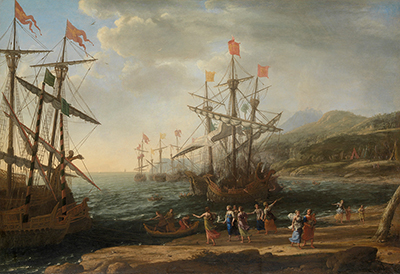The Trojan Women Setting Fire to Their Fleet is a painting by Claude Lorrain (Claude Gellée) which now resides within the permanent collection of the Metropolitan Museum of Art in the USA.
The painting is dominated by a number of tall ships, whose flags flutter in the coastal wind. A number of figures on the shore wave their arms about in an active scene which contrasts to most of the artist's other work in which a more relaxed atmosphere can be found. There is a tall ship to the left which helps to frame that side of the painting, and then a small slither of land sweeping across the bottom of the composition. To the right hand side we find several tall hills which slowly drift behind the overhanging clouds. The central area is an open expanse of water which leads through to the horizon. A blue sky dominates the upper half of the work, with clouds coming in from the right hand side in order to produce a variety of dark and light tones within the painting. Although the artist would nor normally feature ships in as much detail as this, most of the rest of The Trojan Women Setting Fire to Their Fleet is entirely in keeping with the rest of his career.
The content itself represents the women of Troy setting fire to the ships within this scene for the purpose of forcing their population to finally set down some roots. They had moved many times after the Greeks had seized their city and they had grown tired of this endless relocating. To burn their own boats seems somewhat extreme but is ideally suited content for artists such as Claude, particularly considering how they could also bring their landscape talents into the piece without it feeling too contrived. Aeneas would then ask Jupiter to bring rain down onto the ships in order to save them, and the artist represents this by the clouds to the right which appear from over the hills in the distance. Cardinal Girolamo Farnese would commission this piece in around 1643, shortly after returning to Rome. Claude lived much of his life in this city and had many of his most notable patrons within Rome.
The Metropolitan Museum of Art host this artwork along with a good number of other artworks from Claude's career. Most of these are pen and wash drawings, for which he was also famous, but there are also some other oil paintings to be found here too, including View of La Crescenza, Sunrise and The Ford. Due to the huge amount of work found in this gallery, not all of their collection will necessarily be out on display when you make a visit, so check ahead if there is a specific item that you would like to see in person. Claude Lorrain himself is a valuable addition because of how he connects French and Italian art together, as well as linking to later art movements within the UK as well. Most of his paintings today reside within those nations, with only a few to be found across the US.




